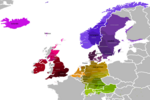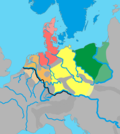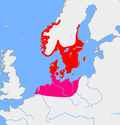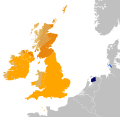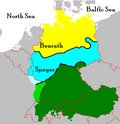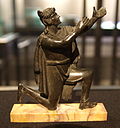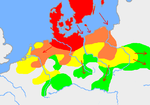The West Germanic languages constitute the largest of the three branches of the Germanic family of languages (the others being the North Germanic and...
56 KB (4,765 words) - 16:59, 16 June 2024
The Germanic languages are a branch of the Indo-European language family spoken natively by a population of about 515 million people mainly in Europe...
93 KB (9,478 words) - 18:43, 24 June 2024
The Germanic languages include some 58 (SIL estimate) languages and dialects that originated in Europe; this language family is part of the Indo-European...
15 KB (1,110 words) - 20:32, 12 June 2024
North Germanic languages make up one of the three branches of the Germanic languages—a sub-family of the Indo-European languages—along with the West Germanic...
57 KB (5,429 words) - 10:22, 25 March 2024
East Germanic is one of the primary branches of Germanic languages, along with North Germanic and West Germanic. The only East Germanic language of which...
9 KB (917 words) - 19:51, 29 May 2024
Proto-Germanic (abbreviated PGmc; also called Common Germanic) is the reconstructed proto-language of the Germanic branch of the Indo-European languages. Proto-Germanic...
130 KB (12,145 words) - 15:04, 7 June 2024
North Sea Germanic, also known as Ingvaeonic (/ˌɪŋviːˈɒnɪk/ ING-vee-ON-ik), is a postulated grouping of the northern West Germanic languages that consists...
10 KB (1,100 words) - 23:36, 10 May 2024
Weser–Rhine Germanic is a proposed group of prehistoric West Germanic dialects, which includes both Central German dialects and Low Franconian, the ancestor...
6 KB (513 words) - 14:38, 27 March 2024
Frisian) varieties of the West Germanic languages. The Anglo-Frisian languages are distinct from other West Germanic languages due to several sound changes:...
24 KB (1,652 words) - 20:11, 8 June 2024
took place separately in various Germanic languages starting around 450 or 500 CE and affected all of the early languages except Gothic. An example of the...
54 KB (5,347 words) - 09:26, 29 May 2024
The Frisian languages (/ˈfriːʒən/ FREE-zhən or /ˈfrɪziən/ FRIZ-ee-ən) are a closely related group of West Germanic languages, spoken by about 400,000 Frisian...
33 KB (3,465 words) - 04:54, 6 March 2024
The Germanic parent language (GPL), also known as Pre-Germanic Indo-European (PreGmc) or Pre-Proto-Germanic (PPG), is the stage of the Germanic branch...
10 KB (1,243 words) - 18:47, 25 May 2024
West Germanic gemination was a sound change that took place in all West Germanic languages around the 3rd or 4th century AD. It affected consonants directly...
7 KB (641 words) - 13:08, 7 April 2024
High German consonant shift (redirect from High Germanic languages)
Proto-Germanic, the resulting language, Old High German (henceforth, OHG), can be neatly contrasted with the other continental West Germanic languages, which...
61 KB (6,464 words) - 10:13, 25 June 2024
In the Germanic languages, weak verbs are by far the largest group of verbs, and are therefore often regarded as the norm (the regular verbs). They are...
60 KB (5,115 words) - 10:53, 22 June 2024
Northwest Germanic is a proposed grouping of the Germanic languages, representing the current consensus among Germanic historical linguists. It does not...
10 KB (1,207 words) - 16:01, 21 June 2024
proto-languages. North Sea Germanic Weser–Rhine Germanic Stefan Müller, Germanic syntax: A constraint-based view, series: Textbooks in Language Sciences...
6 KB (483 words) - 05:42, 13 May 2024
*Frenkisk), also known as Old Franconian or Old Frankish, was the West Germanic language spoken by the Franks from the 5th to 9th century. After the Salian...
59 KB (4,839 words) - 19:30, 9 June 2024
which there are eight groups with languages still alive today: Albanian, Armenian, Balto-Slavic, Celtic, Germanic, Hellenic, Indo-Iranian, and Italic;...
112 KB (10,237 words) - 16:51, 23 June 2024
the use of ancient and early medieval Germanic languages and are thus equated at least approximately with Germanic-speaking peoples, although different...
163 KB (20,175 words) - 20:28, 21 June 2024
turn divided into North, West and East Germanic groups, and ultimately produced a large group of mediaeval and modern languages, most importantly: Danish...
29 KB (2,932 words) - 13:50, 18 June 2024
Germanic. South Germanic mythology East Germanic languages North Germanic languages West Germanic languages Marchand 2016. Sonderegger 1979. Schwarz 1951...
5 KB (567 words) - 22:57, 11 January 2024
dedicated to language families and geographic groups of languages, and 10 sub-classifications of literature (4 subclasses contain both languages and literatures)...
44 KB (4,269 words) - 02:20, 20 June 2023
Scandinavian languages. This common, but not direct, ancestor (proto-language) of all contemporary Germanic languages is called Proto-Germanic, commonly...
16 KB (1,616 words) - 09:28, 29 May 2024
Low German (redirect from Low Germanic language)
Frisian and English, with which it forms the North Sea Germanic group of the West Germanic languages. Like Dutch, it has historically been spoken north of...
133 KB (11,048 words) - 14:17, 19 June 2024
the language about which nothing is known. Lombardic is classified as part of the Elbe Germanic (Upper German) group of West Germanic languages, most...
27 KB (2,859 words) - 09:56, 9 June 2024
Saxon) and Low Franconian (including Dutch) within the continental West Germanic dialect continuum. As a technical term, the "high" in High German is...
10 KB (891 words) - 02:39, 21 May 2024
motifs from the early Germanic period. Linguistic reconstructions can be obtained via comparison between the various Germanic languages, comparison with related...
72 KB (1,709 words) - 16:41, 9 May 2024
mainly Romance, languages. As a Germanic language, Gothic is a part of the Indo-European language family. It is the earliest Germanic language that is attested...
92 KB (9,677 words) - 19:13, 30 May 2024
In the Germanic languages, a strong verb is a verb that marks its past tense by means of changes to the stem vowel. The majority of the remaining verbs...
126 KB (12,242 words) - 23:40, 24 June 2024


